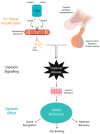Sobriety and Satiety: Is NAD+ the Answer?
- PMID: 32423100
- PMCID: PMC7278809
- DOI: 10.3390/antiox9050425
Sobriety and Satiety: Is NAD+ the Answer?
Abstract
Nicotinamide adenine dinucleotide (NAD+) is an essential pyridine nucleotide that has garnered considerable interest in the last century due to its critical role in cellular processes associated with energy production, cellular protection against stress and longevity. Research in NAD+ has been reinvigorated by recent findings that components of NAD+ metabolism and NAD-dependent enzymes can influence major signalling processes associated with the neurobiology of addiction. These studies implicate raising intracellular NAD+ levels as a potential target for managing and treating addictive behaviour and reducing cravings and withdrawal symptoms in patients with food addiction and/or substance abuse. Since clinical studies showing the use of NAD+ for the treatment of addiction are limited, this review provides literature evidence that NAD+ can influence the neurobiology of addiction and may have benefits as an anti-addiction intervention.
Keywords: NAD+, cocaine; addiction; alcohol; cellular energetics.
Conflict of interest statement
The authors declare no conflict of interest.
Figures




References
-
- Dimitrijević I., Popović N., Sabljak V., Škodrić-Trifunović V., Dimitrijević N. Food addiction-diagnosis and treatment. Psychiatr. Danub. 2015;27:101–106. - PubMed
-
- Pucci M., Di Bonaventura M.V.M., Wille-Bille A., Fernández M.S., Maccarrone M., Pautassi R.M., Cifani C., D’Addario C. Environmental stressors and alcoholism development: Focus on molecular targets and their epigenetic regulation. Neurosci. Biobehav. Rev. 2019;106:165–181. doi: 10.1016/j.neubiorev.2018.07.004. - DOI - PubMed
Publication types
LinkOut - more resources
Full Text Sources
Other Literature Sources

